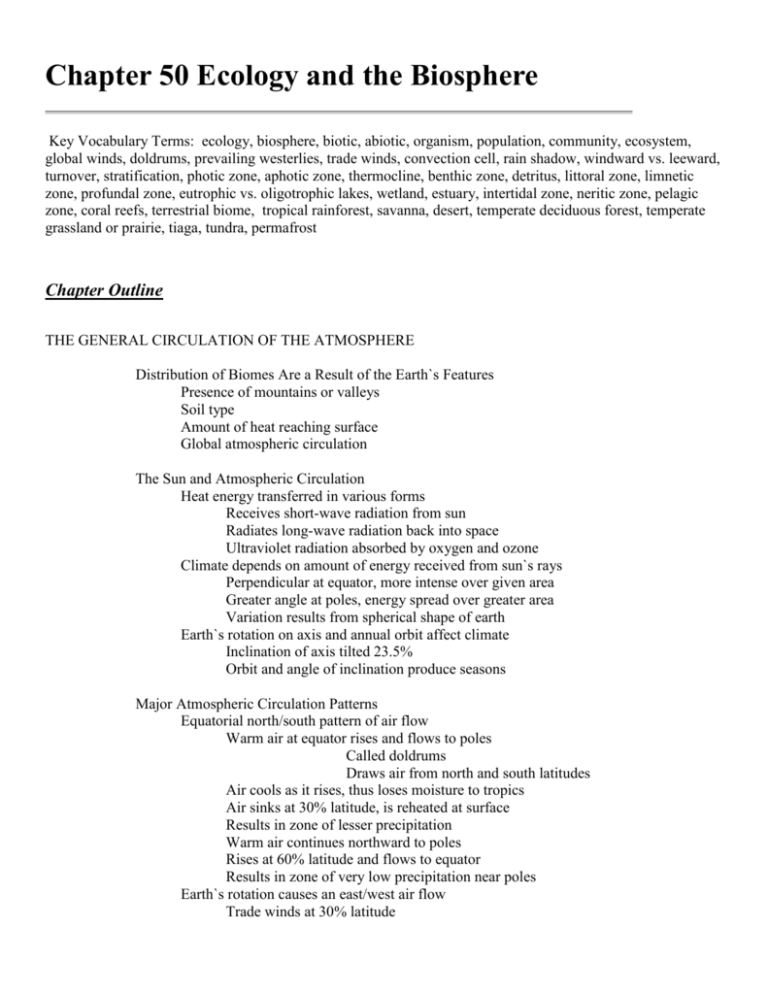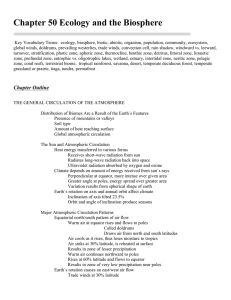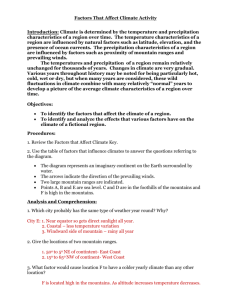Chapter 50
advertisement

Chapter 50 Ecology and the Biosphere Key Vocabulary Terms: ecology, biosphere, biotic, abiotic, organism, population, community, ecosystem, global winds, doldrums, prevailing westerlies, trade winds, convection cell, rain shadow, windward vs. leeward, turnover, stratification, photic zone, aphotic zone, thermocline, benthic zone, detritus, littoral zone, limnetic zone, profundal zone, eutrophic vs. oligotrophic lakes, wetland, estuary, intertidal zone, neritic zone, pelagic zone, coral reefs, terrestrial biome, tropical rainforest, savanna, desert, temperate deciduous forest, temperate grassland or prairie, tiaga, tundra, permafrost Chapter Outline THE GENERAL CIRCULATION OF THE ATMOSPHERE Distribution of Biomes Are a Result of the Earth`s Features Presence of mountains or valleys Soil type Amount of heat reaching surface Global atmospheric circulation The Sun and Atmospheric Circulation Heat energy transferred in various forms Receives short-wave radiation from sun Radiates long-wave radiation back into space Ultraviolet radiation absorbed by oxygen and ozone Climate depends on amount of energy received from sun`s rays Perpendicular at equator, more intense over given area Greater angle at poles, energy spread over greater area Variation results from spherical shape of earth Earth`s rotation on axis and annual orbit affect climate Inclination of axis tilted 23.5% Orbit and angle of inclination produce seasons Major Atmospheric Circulation Patterns Equatorial north/south pattern of air flow Warm air at equator rises and flows to poles Called doldrums Draws air from north and south latitudes Air cools as it rises, thus loses moisture to tropics Air sinks at 30% latitude, is reheated at surface Results in zone of lesser precipitation Warm air continues northward to poles Rises at 60% latitude and flows to equator Results in zone of very low precipitation near poles Earth`s rotation causes an east/west air flow Trade winds at 30% latitude From east-southeast to west in southern hemisphere From east-northeast to west in northern hemisphere Prevailing westerlies at 30 to 60% latitude Blow from west to east Dominate climate patterns Weak zones of east to west winds at extreme latitudes Atmospheric Circulation, Precipitation, and Climate Precipitation related to air temperature Warm air holds more moisture than cool air Greater rainfall when air rising and being cooled Lesser rainfall when air falling and being warmed All great deserts at near 60% latitude Other major deserts at continental interiors Other deserts on leeward side of mountain ranges Rain shadow effect: drier on windward side of mountain Areas with climate resembling the Mediterranean Small, isolated and widely separated areas California, southwestern Oregon Central Chile Southwestern Australia Cape region of South Africa Prevailing westerlies blow from cool ocean to warm land Air holds moisture, thus precipitation limited during summer Monsoon conditions of India and southern Asia Winter trade winds blow east-northeast onto ocean Summer winds blow east-southeast onto land Results in heavy rains in certain regions Patterns of Circulation in the Ocean Oceanic air circulation modified by land masses Surface gyrals dominate ocean circulation Clockwise in north, counterclockwise in south Redistribute heat and affect continental climates Gulf Stream carries warmth to England and western Europe Humboldt Current carries cold water up the west U.S. coast FRESH WATER Limited in Area, About 2% of Earth`s Surface Strongly connected to terrestrial habitats Marshes and swamps constitute intermediate zones Supplied with nutrients from nearby land communities Freshwater organisms generally restricted to that habitat Ponds and Lakes Subdivided into Three Zones Littoral zone: shallow waters along edge of land Limnetic zone: top layer of open water Profundal zone: deep-water areas with no light penetration Large Lakes Exhibit Thermal Stratification Summer conditions Upper epilimnion layer Lower, cooler hypolimnion layer Layer of temperature change called thermocline Fall conditions Epilimnion temperature drops; layers mix Called fall overturn Winter conditions Water most dense at 4% C, thus cooler surface water freezes Water below ice remains between 0% and 4% Spring conditions Water warms and mixes with cool water below Called spring overturn Lakes Divided into Two Productivity Categories Eutrophic lakes Abundant minerals, organic matter In summer oxygen is depleted below the thermocline Overturns redistribute nutrients and oxygen Oligotrophic lake Organic matter and nutrients relatively scarce Frequently very deep Deep water always rich in oxygen More drastically affected by pollution and algal blooms THE OCEANS Dominate Earth`s Surface Composition Three quarters of surface covered by water Average depth of three kilometers Photosynthetic organisms limited to upper surface Water density affects mineral and gas solubility Warm water holds less oxygen than cold Carbon dioxide not limited in oceans Mineral distribution more uniform than on land Fewer number of species in ocean than on land Greater variety of niches on land All phyla represented in oceans, but few species of each Few phyla represented on land, but many species of each Three Major Kinds of Oceanic Habitats Neritic zone: shallow waters along coasts Surface zone: top layer of open ocean Abyssal zone: deep-water areas of ocean The Neritic Zone Inhabited by comparatively large number of species Intense, violent interactions between land and sea Intertidal (littoral) region exposed when tide recedes Inhabitants generally well-secured Provided transition from ocean to land habitats Organisms adapted to resist desiccation Abundant nutrients from land support great continental shelf fisheries Heavily populated areas, like Chesapeake Bay, damaged Coral reefs occur in tropical waters Highly-productive ecosystems in nutrient-poor waters Productivity related to photosynthetic organisms The Surface Zone Composed of microscopic plankton and macroscopic nekton Photosynthetic plankton accounts for 40% of all photosynthesis on earth Heterotrophic organisms abundant Largest animals (whales) feed directly on plankton Great fluctuations in populations of plankton Results in rapid turnover of nutrients Productivity of region may be grossly underestimated The Abyssal Zone Area of sea floor twice that of exposed land masses Sea floor covered by thick layer of fine mud Initially expected to contain little life High pressures, low temperature Absence of light and lack of food sources Recent discovery of wide array of life Free-swimming frequently bioluminescent animals Clusters of organisms around deep-sea thermal vents Depend on chemosynthesis rather than photosynthesis Superheated water rich in reduced compounds Bacteria contained in animal tissue provides food BIOMES Biomes Are Terrestrial Communities Occurring Over Wide Areas Classified by General Features of Vegetation Climatically Delineated If earth`s surface were uniform(nomountains or oceans), bands would be formed Changes in altitude mimic changes in latitude Tropical Rain Forests Substantial rainfall throughout year Richest biome in terms of number of species Great diversity of life forms in well-lighted upper regions Epiphytes in tree branches Vines characteristic of tropical forests Hemiepiphytes begin as epiphytes, later grow roots into soil Life forms highly specialized and unusual Composition of soils Frequently acidic Deficient in phosphorus, potassium and other nutrients May contain toxic levels of aluminum Most nutrients concentrated in trees and other life forms Fragile regions readily damaged by human populations Cleared land does not sustain continued agriculture Increased populations cannot be supported Cleared forests take decades to recover Destruction accompanied by loss of vast diversity of life Organisms of great scientific interest Potentially important to the quality of human life Desert Extremely low rainfall Concentrated within continents and at 20 to 30% latitudes Greatly fluctuating daily temperatures Extreme heat during day Rapidly radiate heat at night, may drop 30 C Sparse vegetation, primarily annual plants May pass dry season in form of seeds Germinate and grow rapidly after rainfall Trees and shrubs exhibit deep root systems May be deciduous or evergreen Convergent evolution: unrelated organisms appear superficially similar Succulents common, exhibit CAM photosynthesis Animal life may limit activity to specific seasons Possess unique adaptations Live in moist, deep burrows and emerge at night Exhibit water-resistant cuticles and exoskeletons May estivate to avoid hot, dry conditions Savannas Reduced rainfall with prolonged dry seasons Open grassland with scattered shrubs and trees Trees generally deciduous and lose leaves in dry season Constitution maintained by periodic fires Nutrient-poor soils are especially high in aluminum Wider fluctuations in temperature than rain forests Characteristic large grazing mammals Widespread in North America during Pleistocene Epoch Temperate Grasslands Common in interior of Eurasia, South America,and pre-colonial North America Highly productive when converted to agriculture due to rich soil Grasslands with long, cold winters Variety of plant forms dependent on rainfall Tall-grass prairies with moderate rainfall Forests with abundant rainfall Short-grass prairies with lower rainfall Sensitive to overuse Mismanagement results in desert formation Populated by herds of grazing mammals Maintained by grazing and periodic fires Temperate Deciduous Forests Exemplified by forests of Eastern U.S., Canada, Eurasia Life forms changing with climatic conditions World climate becoming cooler, drier and more seasonal Eastern North America resembles western China Moderate rainfall Distributed throughout seasons Moisture not available during cold winters Many areas possess rapidly growing perennial herbs Taiga Northern coniferous forests of Eurasia and North America Long, cold dry winters with most precipitation in summers Deep blanket of snow in winter Protects ground from freezing, allows for growth of forest Changes in day length as a result of latitude Short days in winter Long days in summer Rapid plant growth in summer months Willows, birches common around lakes and marshes Alders with nitrogen-fixing bacteria inhabit infertile glacial soils Variety of animal life Large mammals: elk, moose, wolves Small mammals: rodents Tundra Farthest north, excluding regions of permanent ice Extremely uniform appearance Types of vegetation Small trees around open water Mostly grasses, sedges, heathers and lichens Grow rapidly in summer months Very low precipitation Water sits on frozen ground in summer Permanent ice, permafrost near surface Various animal life, especially during short summers







